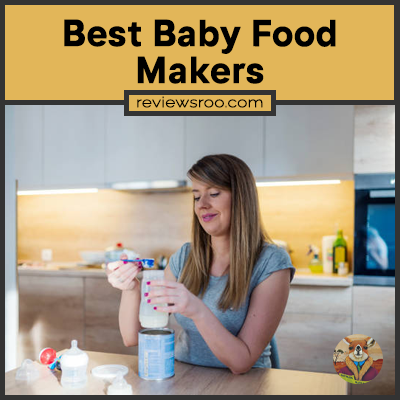Best Baby Food Makers
Parents want the best for their babies. One of the best ways to ensure a healthy start for your little one is to make sure they’re eating the right food. But with so many baby food makers on the market, it’s hard to know which one is best. We’ve done the research for you and found the top three baby food makers that’ll help you create nutrient-packed meals for your child. Read on to find out which ones made the cut.

The first thing parents should consider when buying a baby food maker is convenience. Does it save time? Can it perform multiple functions? The second factor is safety, as some products may contain toxins or small parts that can be hazardous. Last but not least, budget and value should come into play when choosing a baby food maker, as some options are more cost effective than others.
We’ve taken all these factors into account and compiled a list of the best baby food makers on offer today. Whether you’re looking for convenience, safety or budget-friendly options, rest assured that we’ve found something to suit your needs. So let’s take a look at our top picks!
Types Of Baby Food Makers
Making your own baby food is a great way to know what goes into your baby’s meals. There are several types of baby food makers available. Blenders, food mills, and steamers each offer different benefits.
Blenders can be used to puree cooked vegetables, fruits, and meats into smooth baby food. Food mills are used to mash cooked foods into a finer texture. Steamers can be used to quickly cook vegetables and fruits in their own juices, preserving nutrients and flavors.
Each type of baby food maker has its own advantages depending on the ingredients being used and the desired consistency of the meal. Understanding each will help you make an informed decision on which one would work best for you and your family.
Advantages Of Using A Baby Food Maker
Making homemade baby food can be a time-consuming task. But with a baby food maker, you can simplify the process and create fresh meals quickly. Here are four advantages of using one:
- Easy to Use: Baby food makers are user-friendly, so even beginner cooks can make nutritious meals for their little ones.
- Save Time: These machines help you save time in the kitchen by streamlining the cooking process into an easy few steps.
- Versatile: You can use them to prepare a wide variety of foods, including all sorts of fruits, veggies, meats and more.
- Cost-Effective: A baby food maker eliminates the need to buy pre-made baby food which can be expensive and not as healthy as homemade options. No matter how busy your life is, you’ll never have to compromise on nutrition when you use a baby food maker. Make mealtime easier while providing your little one with nutritionally balanced meals they’ll love!
Factors To Consider When Choosing A Baby Food Maker
Choosing the right baby food maker is key. There are many factors to consider. It’s important to think about things like size and cost, as well as safety features. Look for a machine that fits your budget and kitchen space. If it won’t fit on the counter, you may have to store it away after each use. Safety is also key when selecting a baby food maker.
Make sure the appliance has all necessary certifications, like ETL or UL listed. Check that the blades are made of stainless steel and any plastic parts are BPA-free. Consider how easy it is to clean too – look for dishwasher-safe components, so you can quickly get back to caring for your baby.
Essential Features Of A Baby Food Maker
When it comes to choosing a baby food maker, there are three key factors to consider: nutrition, convenience and features. And now for the fourth factor – essential features of a baby food maker.
A good baby food maker should have certain features that make creating homemade baby food easier and more enjoyable:
- Ease of Use: It should be easy to operate, with simple controls and functions.
- Quality: It should be made from high-quality materials that won’t rust or break easily.
- Versatility: It should be able to puree multiple types of food items, such as fruits, vegetables, and meats.
- Capacity: It should have a large capacity so you can make enough food for your little one in one go.
- Cleaning Ability: The device should have removable parts that are dishwasher-safe for easy cleaning after use.
These features are important when selecting the right baby food maker for you and your family. Choosing one with these essential features will ensure that you get the most out of your purchase and create yummy meals for your little one. With this in mind, let’s look at safety considerations for baby food makers next.
Safety Considerations For Baby Food Makers
Safety is paramount when it comes to food for your little one. A baby food maker must be designed to avoid any danger of contamination, injury or choking. The following are some of the key considerations you should make when choosing a baby food maker.
First and foremost, ensure that the appliance is certified by an appropriate safety standard; look for UL certification in the US or CE certification in Europe as a minimum requirement. Additionally, any blades used should be sharp enough to blend ingredients effectively but not so sharp that they pose a risk if touched. It’s also wise to check that there are no small parts which could potentially cause choking or other hazards. Finally, select a model with good customer reviews and a reputable manufacturer’s warranty.
With these safety features in mind, it’s time to consider cleaning and maintenance of baby food makers.
Cleaning And Maintenance Of Baby Food Makers
Caring for your baby food maker is like caring for a precious little one. It requires attention and maintenance to ensure it’ll last you through the years. To keep your baby food maker in tip-top shape, here’s what you need to do:
Cleaning:
- Wipe down the exterior with a damp cloth regularly.
- Remove any stains on the interior walls with a non-abrasive scrubber.
- Wash all removable parts in soapy water and rinse them off before putting them back.
Maintenance:
- Check if there are any loose screws or bolts that need tightening every couple of months.
- Make sure all the seals are intact, no cracks, and they fit snugly into place.
- Inspect the blades for sharpness and replace or sharpen them as needed. The effort spent in taking care of your baby food maker will be worth it when you see how long it can last with proper attention. Moving on to another important element, let’s look at how much money you’d have to spend for a baby food maker.
Cost Of Baby Food Makers
Cost can vary widely when it comes to baby food makers. Depending on the features you’re looking for and the size of the machine, prices can range from the low-end of around $30 all the way up to around $150. It’s important to remember that more expensive doesn’t always mean better.
Do your research and read customer reviews to get an idea of what fits best with your needs and budget. Consider also how often you’ll use it so you don’t spend too much on something that will be used only occasionally.
TIP: Look for a baby food maker with adjustable settings and a timer so you can customize your recipes according to the age and texture preference of your little one.
From cost considerations, we move now to popular baby food maker brands.
Popular Baby Food Maker Brands
Many parents have found that popular baby food maker brands can make life easier. Take Marley, a mom of two with limited time on her hands. She says the convenience of having a baby food maker allowed her to spend more time with her children and less time in the kitchen.
Popular baby food makers such as NurtiBullet, BEABA, QOOC, and Cuisinart are becoming commonplace in homes. Each one comes with unique features and advantages to suit parents’ needs. For example, some makers offer full-sized models for large batches or mini versions for small portions. Others may feature multiple speeds and settings to give parents even more control over texture and consistency of their homemade meals.
At the end of the day, parents need to make an informed decision about which brand suits their needs best – but it’s clear these popular brands can make life easier for busy families who want the best for their little ones.
Reviews Of The Best Baby Food Makers
Finding the perfect baby food maker can be overwhelming. With so many brands and options available, it can be hard to decide which one is best. But reviews of the top models can make your search easier.
From Baby Brezza to BEABA, a variety of popular brands offer quality products to make your life easier. Each offers its own features and benefits—some come with additional accessories for making different types of food and others are designed for convenience and ease of use. Now, let’s take a look at some customer reviews from satisfied parents who bought these baby food makers.
Customers have praised the Baby Brezza for its easy-to-use design, noting that it’s great for busy parents who don’t have time to spend hours in the kitchen prepping meals. The BEABA is also highly recommended, as it has a wide range of settings that allow you to create a variety of delicious recipes quickly and easily. Other customers have noted that the Cuisinart Baby Food Maker is ideal for those on a budget, as it comes with all the necessary accessories without breaking the bank.
No matter which model you choose, there are plenty of reviews online that will help you make an informed decision when it comes to choosing the best baby food maker for your needs.
Alternatives To Baby Food Makers
When it comes to making baby food, there are a few different options. Apart from the traditional baby food makers, there are alternatives available. Here are ten of them:
- Blenders and food processors: These can do much more than just make purees; they can also chop and grind up solid foods like carrots and peas.
- Baby food mills: These come with several discs that you can use to grind up different types of fruits and vegetables into fine purees for your baby.
- Hand mashers: This is an old-fashioned way of making baby food by mashing up soft foods with a fork or potato masher.
- Immersion blenders: These are handheld blenders that you can use to quickly puree any type of fruit or vegetable for your baby’s meals.
- Ice cube trays and silicone freezer bags: With these items, you can freeze pre-made portions of pureed fruits and vegetables for easy storage and reheating later on.
These alternatives to traditional baby food makers provide an easy way to make healthy meals for your little one without the need for special equipment or gadgets. Plus, they’re cost effective too! All you need is some fresh produce, a blender (or other tool), and maybe some ice cube trays or freezer bags – the rest is up to you!
Frequently Asked Questions
How Easy Is It To Use A Baby Food Maker?
Baby food makers are a great way to make sure your baby gets the best, healthiest nutrition. But how easy is it to use one?
It depends. Most models are simple and straightforward, with buttons that allow you to easily select settings and begin making food. Others might require more steps, such as adding ingredients and measuring the right amounts. Some models also come with helpful recipes and guidance on what foods are age-appropriate for your baby.
Overall, baby food makers vary in their ease of use. However, if you take some time to read the instructions and watch tutorials, they can be a great way to quickly make healthy meals for your little one.
Is It Worth The Cost To Buy A Baby Food Maker?
The age-old question, is it worth the cost to buy a baby food maker? The answer might surprise you. From convenience to nutrition, there are plenty of benefits to having your own baby food maker.
For starters, it’s hard to beat the ease of use that comes with having your own device. Just plug it in and pop in whatever fruits or veggies you have on hand and voila – perfectly pureed, nutritious meals for your little one. Plus, with most machines you can steam and puree all at once. That means no more time spent babysitting pots on the stove or scrubbing stuck-on chunks from blender blades.
Plus, because you control what goes into the mix, you know exactly what nutrients your baby is getting. You can even make sure that any allergies are taken into account as well as adjust for texture as they grow older. And if you’re really pressed for time, many machines allow you to batch cook ahead so you’ll never be without healthy options! In short, investing in a baby food maker is an investment in time, money and nutrition – all crucial components of raising a healthy child.
Are There Any Baby Food Makers That Are Bpa Free?
The search for the perfect baby food maker often leads to the question of safety. Are there any that are BPA free?
This is a crucial inquiry, as it can be the difference between feeding our little ones nutritious goodness and unknowingly exposing them to potentially hazardous toxins. It’s a no-brainer: we want only the best for our babies.
Fortunately, there are products available that meet this requirement. They’re made from foodsafe materials and are easy to clean and maintain. Plus, they come with helpful recipes and instructions so parents feel confident in their choice. With these options at our disposal, we can ensure our babies get the healthy start they deserve without worrying about potential dangers.
Do I Need To Use A Special Type Of Container When Using A Baby Food Maker?
You’ve decided to buy a baby food maker for your little one, but have you considered the type of container you need? Amazingly, the answer is yes. Coincidentally, it’s not just any container that will do.
When using a baby food maker, special attention needs to be paid to the type of container you use. BPA-free containers are ideal and make sure that your little one gets only the best nutrition. Additionally, these containers typically come with features like a safety lock to keep your precious cargo safe and secure. It’s also important to make sure that the containers are appropriately sized; too small a container can lead to spillage and messes while too big can cause overfilling and waste.
So when looking for a baby food maker, make sure you take into account what kind of container you’ll need – one that’s safe, secure and appropriately sized for your baby’s needs.
Are There Any Recipes Available For Making Baby Food With A Baby Food Maker?
Baby food makers are great for creating homemade meals for children. But they can also be a bit confusing if you’re not sure what recipes to use.
So, are there any recipes available for making baby food with a baby food maker? Absolutely. Many websites offer recipes specifically designed for use in a baby food maker. Plus, some baby food makers come with recipe books and instructions on how to get the most out of your machine. So you’ll be able to easily create delicious meals that your child will love.
Conclusion
It’s easy to make baby food with a baby food maker. Not only is it time-saving, but it also offers parents peace of mind knowing their little one is getting the nutrition they need. Plus, there are plenty of BPA free models, so safety is never a concern.
The cost of a baby food maker can be worth it in the long run, especially when you consider all the money you’ll save making your own purees and snacks at home. I also found tons of recipes online for easy-to-make baby food that can help get you started.
Finally, keep in mind you don’t need to use any special containers when using a baby food maker; just make sure whatever container you use is microwave safe. So if you’re looking for an easier way to prepare your little one’s meals, investing in a quality baby food maker could be just what you need.





